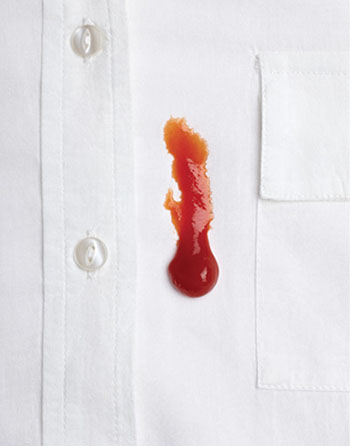Guide C-502
Revised by Wendy Hamilton
College of Agricultural, Consumer and Environmental Sciences, New Mexico State University
Author, Extension Grants and Contracts Development Specialist, College of Agricultural, Consumer and Environmental Sciences, New Mexico State University. (Print Friendly PDF)
Principles for Removing Stains
Damage created by spots and stains or their improper removal is one of the most common causes of discarded clothing. Use this guide to reduce the amount you spend on replacements for damaged clothing.
- Try to find out what the stain is. What do you know about it? Do you know what made it? Where on the garment is it? Could it be food or oil? What does it smell like? Some spills have a tell-tale smell. How does it feel? Is it oily, sticky, hard?
- Deal with the stain as soon as possible. Set-in stains are harder to remove.
- Carefully blot or scrape excess stains from the fabric surface.
- Be sure the removal method will be safe for the fabric as well as effective for taking out the stain. Refer to the garment’s permanent care label. Always test the removal method on an inside seam or hem. Home methods are usually safe for washable fabrics. For “dry clean only” fabrics, use only a dry-cleaning agent, or ask a dry cleaner for help. Some examples of dry-cleaning agents are K2r, Carbona, Energine, and Brush Top (double knit cleaner and rust stain remover).
- Baste an “X” near the spot. This makes it easier to find the stain when the article is wet, or when working from the wrong side of the fabric.
- Heat sets stains. Do not press a stained fabric or dry it in the dryer.
- Old remedies such as applying milk to ink stains are unreliable. The milk may produce an additional stain or set the existing stain.
- Some stains, such as soft drinks or fruit juices, may be invisible or difficult to see because of fabric design.
- Use the gentlest removal method first.
- Do not mix stain removers (especially ammonia and chlorine bleach). If more than one remover is needed, rinse thoroughly between the use of each.
- Follow instructions carefully for the use, storage, and safety of all cleaning agents. Always use in a well-ventilated room.

© Picsfive | Dreamstime.com
Unknown Stains
Don’t give up if you cannot tell what the stain is. Work through this list until the stain disappears.
- Soak in cold water for about 30 minutes.
- Work a little liquid laundry detergent, shampoo, or dishwashing liquid into the stain. Leave for about 30 minutes. Rinse.
- Wash with bleach that is safe for the fabric. (Read the fabric care label for this information and follow the directions on the container.)
- Soak overnight in a laundry pre-soak, such as Axion or Biz. (This is very good for stains such as milk, egg, blood, and perspiration.) If you do not have a pre-soak powder, use any laundry detergent.
- Wash in detergent in the hottest water safe for the fabric—very hot for cotton and linen, hand-hot for synthetics such as nylon, and just warm for woolens.
- If washing does not remove a grease stain, let the article dry. Sponge the stain with grease solvent. Air the garment to remove any solvent fumes.
- Use a commercial rust remover or color remover. Follow the instructions carefully. First, test a seam for colorfastness. This is a harsh process and should only be used if the other methods fail.
- Mix equal parts of bleach and water. This is a harsh treatment, which may be harmful to the fabric. Use only as a last resort.
Your Stain Removal Kit
Remember that some of these stain removers are poisonous and dangerous. Keep them locked up and out of children’s reach.
Absorbents—Used to “soak up” stains from fabrics
- White paper towel or tissue
- Soft white cloth
- Cornstarch or cornmeal
- Sponge
- Test with stain remover to make sure it will not be damaged.
Solvents—Used to dissolve stains like grease or oil
- Liquid dishwashing detergent
- Shampoo
- Detergent
- Dry-cleaning agent such as Energine, Carbona, K2r, or Brush Top
- Nail polish remover (dissolves acetate, so test on an inside seam if you are not sure what the fiber is).
Bleach—Removes unwanted color
- Lemon juice
- Hydrogen peroxide: You can get this at a drug store if you don’t have any at home.
- Chlorine bleach: This is best for white cotton and linen.
- All-fabric bleach: This is safer for colors and permanent press fabrics.
Other
- Salt
- Vinegar
- Ammonia
- Laundry pre-soak powders such as Biz or Axion
Equipment (Keep just for removing stains. Do not use for other household tasks.)
- Stainless steel spoon
- Nail brush or old tooth brush
- Containers for soaking stains
- China, glass, stainless steel, and unchipped enamel are best for container soaking.
Brand names appearing in publications are for product identification purposes only. No endorsement is intended, nor is criticism implied of similar products not mentioned. Persons using such products assume responsibility for their use in accordance with current label directions of the manufacturer.
For Further Reading
C-313: Rags to Riches: Recycling and Upcycling Old Clothes
https://pubs.nmsu.edu/_c/C313/
C-315: Determining Personal Colors
https://pubs.nmsu.edu/_c/C315/
C-503: Getting Clothes Clean
https://pubs.nmsu.edu/_c/C503/
<Original author: Susan Wright, Extension Clothing and Textiles Specialist.

Wendy Hamilton is an Extension Evaluation and Accountability Specialist at New Mexico State University who provides expertise for program development and evaluation. She has worked at four land-grant universities, and has a diverse background in textiles and clothing, adult education, 4-H youth-at-risk, horticulture, evaluation, and grant writing.
To find more resources for your business, home, or family, visit the College of Agricultural, Consumer and Environmental Sciences on the World Wide Web at pubs.nmsu.edu.
Contents of publications may be freely reproduced, with an appropriate citation, for educational purposes. All other rights reserved. For permission to use publications for other purposes, contact pubs@nmsu.edu or the authors listed on the publication.
New Mexico State University is an equal opportunity/affirmative action employer and educator. NMSU and the U.S. Department of Agriculture cooperating.
Revised August 2019 Las Cruces, NM


